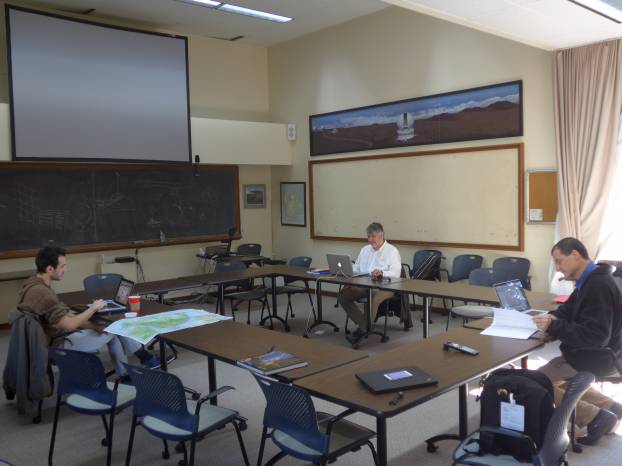CFHT / IRTF Venus campaign - Preparation

January 15th, 2016
We’ve just arrived in Hawaii to conduct an observing run of Venus using the Canada France Hawaii Telescope (CFHT), located at 4200 m altitude on the summit of Mauna Kea, Hawaii. In this observing run we will be using the ESPADONS spectrograph to record the spectrum of reflected sunlight from the dayside of Venus. The extremely high spectral resolution of ESPADONS allows us to measure the Doppler shifts caused by the motion of the clouds on Venus. This lets us map the winds at the cloud-tops of Venus, with an accuracy of typically around +/- 10 m/s. The team consists of EuroVenusians Thomas Widemann (Paris Observatory), Pedro Machado (Institute of Astrophysics and Space Sciences, in Lisbon, Portugal) and Colin Wilson (Oxford University). We flew in to Hawaii late last night and are spending today at CFHT headquarters, in the town of Waimea. We have spent today having safety briefings and logistics meetings; I have also given a seminar to CFHT staff outlining results from Venus Express and the synergies of ground-based and space-based observations.
Our CFHT observations will be conducted in co-odination with simultaneous observations from NASA’s IRTF telescope, also on Mauna Kea, conducted by Therese Encrenaz, also a EuroVenusian, also from Paris observatory. Her measurements, using the TEXES imaging spectrograph, will map sulphur dioxide (SO2) in the upper atmosphere of Venus. She is observing for 8 nights in a row, for approximately 5 hours each night. Her maps will reveal how sulphur dioxide varies on different timescales, from hour-to-hour, to day-to-day scales. She will be observing three different wavelengths to probe SO2 abundances, which are sensitive at slightly different altitudes; this gives us a 3-D perspective of SO2 behaviour at the cloud-tops. Comparison with simultaneously measured wind velocities from our CFHT measurements may also yield understanding of how SO2 plumes are affected by winds.
Our CFHT observations will be conducted in co-odination with simultaneous observations from NASA’s IRTF telescope, also on Mauna Kea, conducted by Therese Encrenaz, also a EuroVenusian, also from Paris observatory. Her measurements, using the TEXES imaging spectrograph, will map sulphur dioxide (SO2) in the upper atmosphere of Venus. She is observing for 8 nights in a row, for approximately 5 hours each night. Her maps will reveal how sulphur dioxide varies on different timescales, from hour-to-hour, to day-to-day scales. She will be observing three different wavelengths to probe SO2 abundances, which are sensitive at slightly different altitudes; this gives us a 3-D perspective of SO2 behaviour at the cloud-tops. Comparison with simultaneously measured wind velocities from our CFHT measurements may also yield understanding of how SO2 plumes are affected by winds.

